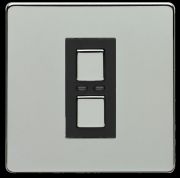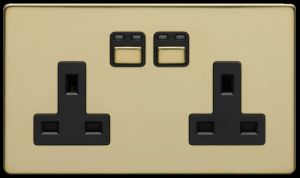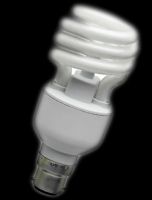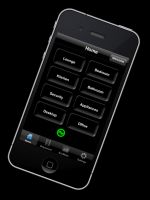LightwaveRF Connect Home Automation Explored
Full home automation solutions aren't cheap. Fortunately, thanks to this British company, swapping your mains sockets and light switches to LightwaveRF brings an amazing amount of automation power, for very little cost. We explore the offering in more detail.
What is LightwaveRF?
 The logo on the right is one to watch out for - it signifies that a product supports the LightwaveRF protocol, meaning that it can form part of a low-cost home automation solution.
The logo on the right is one to watch out for - it signifies that a product supports the LightwaveRF protocol, meaning that it can form part of a low-cost home automation solution.
The range of LightwaveRF products includes replacement mains sockets, energy efficient lightbulbs, lighting dimmer switches and other various accessories designed to offer control over the electrical items in your home. You can also control your home using an iPhone when you're away.
LightwaveRF Interview
We met up with John Shermer, the Chief Executive of LightwaveRF at the 2011 Home Technology Event in London, and asked John to explain a little more about what his new range of products has to offer:
|
FrequencyCast Interviews John Shermer from LightwaveRF (9 minutes) |
LightwaveRF Products
Pictures of the products referred to in our interview:
 Remote controlled light dimmer |
 Replacement mains sockets |
 Remote controlled energy efficient bulb |
 Control the lot with the Lightwave RF iPhone app |
More on Lightwave RF
As was covered in our interview, we can expect to hear more about LightwaveRF as products move to the high street, and the logo gains more awareness. From what we saw at Home Technology Event in London, this is a top quality solution, and you can get started into the world of home automation for less than £100.
We liked the comparison with Lego - You can build up the system yourself, it's DIY, and you can expand the system as and when, by buying new accessories, switches and plugs. Controlling the lot from the iPhone is a huge bonus too - meaning you can take better control, set up clever macros to make life easier, and also keep your energy costs lower by switching off electrical products that you don't need.
The ability to lock and disable sockets is a great one too, especially for keeping your kids from using their games consoles and DVD players, when they should be doing their homework.
We're hoping to get hands-on with some of the LightwaveRF products in the near future, so stay tuned for a review of some of the product range soon.
Meanwhile, you can get more details, and get yourself started with some of these great products by visiting www.lightwaverf.com
Interview with LightwaveRF:
We interviewed John Shemer, the boss of LightwaveRF at the show, and featured a short extract in Show 66. Here's a transcript of the full interview:
FrequencyCast Interviews John Shermer from LightwaveRF (9 minutes) |
John:
Well, we've got a whole range of what we call retro-fittable devices. The idea is to steal an idea from Lego, so that you can buy these a bit at a time, let's say a double socket; fit it in your house, and it works like a regular double socket, but it also has a radio receiver in. So once it's installed, I can control it from my sofa with a handset, and if I get ambitious, and start adding light switches and other sockets, I can then add a Wi-Fi device that simply plugs into a router, control it from my iPhone, an iPod Touch, an iPad, or indeed any smartphone.
Carl:
Good grief - so you can actually do this outside, from the house? You don't even have to be in the room?
John:
Yeah, absolutely. It work in two modes: one we call a local mode, so I can literally sit in front of my TV with my iPhone, and create a complete home cinema-style mood, ready to watch a movie, or I can be in the pub and realise I'm going to stay a bit later for that extra pint, and think - maybe I ought to put the lights on, and switch on my house lights from the bar - no problem at all.
Carl:
Fantastic! So that's your light switches. You've also got mains sockets, which do the same, I'm assuming?
John:
That's absolutely right, yeah. You can retro-fit and take a standard light switch, remove it, fit one of our light switches (which is actually a dimmer). It works like a regular dimmer, so Mrs Jones won't be upset, because you can actually press the button, the light comes on; press the button, the light goes off, and there's two very pretty LEDs in the middle to show you it working. Then there's a matching mains socket, so again the same thing - you can plug your socket in, plug a device in - switch it on and off manually, or switch it on and off remotely. A nice little twist with the socket - it comes with a locking remote, so if you've got a troublesome teenager who will not turn that PS3 off, you can in fact lock the power supply off.
Carl:
That's fantastic! Now, the only problem I have is, these light switches and the mains switches, do I need to be a qualified electrician to install them?
John:
No - it falls under the regulations that says it's DIY-able. They're all low cost as well, I mean a double socket's typically around £35 retail. The single dimmer's around £25 retail. You'll find, when you take off your light switch, you've got exactly the same wires you just put back into the new one, stick it back on the wall, and away you go. If you are worried about that, get a local sparky to do it for you, and if he charges you more than £25, he's having you on. It's very easy - very much aimed at the DIY-er.
Carl:
I also understand that you do a special lightbulb - a magic one at that, and that is for your idiots, isn't it?
John:
Yes - okay, I wouldn't like to call them idiots, but yeah, the lightbulb's very nice. It's actually a low-energy lightbulb, it's a CFL, and they've got a bad reputation for giving poor quality light and what have you. Because we design and manufacture all of these products, when it came to the CFL, we weren't satisfied with what's out there. So we actually, from scratch, designed our own. This one when you plug it in, and you literally take your old bulb out, put the new bulb in, you'll be able to switch it on and get 95% brightness straight away - none of this soft, slow build up to full brightness, it'll come on at full brightness. The remote control technology is also built into the bulb, so from that point on you can remotely control it from a handset, from a wall-mounted handset device, or from your iPhone or your iPod Touch. So it literally is a case of, you can create mood lighting in your lounge simply by swapping the bulbs.
Carl:
That's absolutely phenomenal.
Pete:
Right, Pete here - I'm just going to take over there from you for just a second, Carl. A quick question for you: these devices, you say you can access them externally on your iPhone app - does that mean that they have some kind of Mac address or router built in, or is there some other sort of peripheral you need to get access outside of your house?
John:
Well, the device that we sell retails around £99. It simply plugs into your router and it has a Mac address that is recognised by our server. The very first time you use it, it asks you to press a button on your iPhone and press a button on it, so that they are securely paired, and no-one else can use the system. But that's it, in terms of set up - after that, it looks after itself. There aren't any firewall issues or anything like that. Everything you do in terms of creating your moods and settings is backed up on the server automatically.
Carl:
So it seems that your products are all plug in and play? They're like, get up and go stuff?
Pete:
And I'm assuming, from the iPhone app as well, can you do things like set up macros, so a sequence? - when you walk in, it turns on the lights or turns on a light socket - that kind of thing?
John:
Well clearly, you've been peeping, haven't you? - because that's exactly what you can do on the iPhone app, yeah. We've got up to ten sequences with ten steps in between, so you can create almost a James Bond scenario. There's one we do for fun, which is like a wake-up routine - it switches on your bedside lamp first thing in the morning at 10%, nothing too shocking. A minute or two later, it'll go up to 20% - okay, it's trying to give you a gentle nudge now. Then it'll turn the radio on. When it's at that stage, it brings the lighting up full, but by now it's turned on your shower and your lights in the bathroom, really to say, you know - it really is time you got up. By the time you've walked into the shower, downstairs the kitchen lights are now on, and your coffee machine has started, and that's all possible from the free app and the standard products.
Pete:
Now, we've been walking around the Home Technology Event today, and there's a whole bunch of people doing very expensive home automation systems - some of them are in the several thousands of pounds' mark for something along the lines of what you're discussing. I'm assuming though, because you're just looking at existing mains sockets and light switches, you're slightly lower cost than that? Can you just give me a breakdown of how much it would cost to say to a couple of lights and a couple of mains sockets for a room?
John:
Well, a couple of lights and a couple of mains sockets, you're probably looking ... well, you haven't spent a hundred quid yet, but let's throw in the iPhone control, which is the bit everybody likes - say £200, and you're away. To give you an idea, I've got a four-bedroom house - I did the entire house, at retail price, under £800.
Pete:
So where can you actually get these? Who's retailing them at the moment?
John:
Currently they're on our website. We will be retailing in Apple premium resellers, and also in Maplins very soon.
Pete:
Excellent - and what's your website?
John:
LightwaveRF.com.
Carl:
Before I leave you, I can't help but notice how the sexy logo on your shirt is rather green and spectacular. Can you talk me through this? Who designed that?
 John:
John:
Well, funnily enough, it was a guy that gets referred to as a "felt-tip fairy", which I'm not sure is quite fair. He comes up with all the crazy ideas and the crazy designs, but he's also our Apple programmer, so that probably explains a lot. He came up with that logo; it reminded him of the days of the Mysterons - I don't know if anyone goes back that far? He fancied Destiny Angel - I don't know which one was yours. That logo is now on all our products and on the website, and as you say, on the t-shirts, and shortly to be on a baseball cap near you, hopefully.
Carl:
So what you're saying is, as people look out for the Bluetooth logo, they should look out for this one for their home automation?
John:
Yeah, very much so. LightwaveRF is a radio protocol we've developed, which is bit like ZigBee, a bit like Z-Wave, but it's our own. Why didn't ZigBee or Z-Wave? - they're very good, I'm not criticising them. But to be honest, they're a bit top-heavy for the sort of things we wanted to do, and we wanted to achieve the price point that we now have, and the only way to do that was to start from scratch, and write our own complete radio protocol. But we are signing up some interesting partners. Watch this space, because I think a small company called Siemens might be using the logo very shortly.
Carl:
Ooh, I vaguely think ... I may have heard of them.
Pete:
And is that a FrequencyCast exclusive?
John:
It is actually, yes.
Related links: